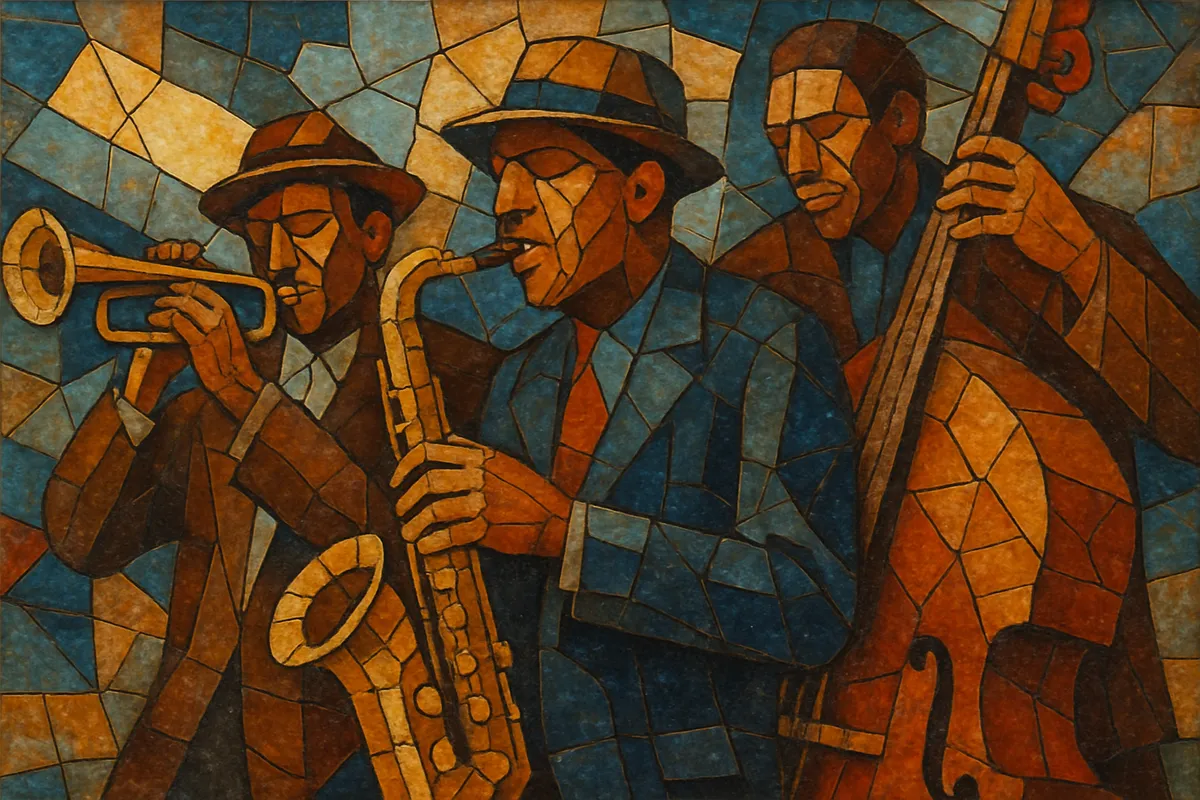Jazz is an improvisation-centered music tradition that emerged from African American communities in the early 20th century. It blends blues feeling, ragtime syncopation, European harmonic practice, and brass band instrumentation into a flexible, conversational art.
Defining features include swing rhythm (a triplet-based pulse), call-and-response phrasing, blue notes, and extended harmonies built on 7ths, 9ths, 11ths, and 13ths. Jazz is as much a way of making music—spontaneous interaction, variation, and personal sound—as it is a set of forms and tunes.
Across its history, jazz has continually hybridized, from New Orleans ensembles and big-band swing to bebop, cool and hard bop, modal and free jazz, fusion, and contemporary cross-genre experiments. Its influence permeates global popular and art music.
Jazz coalesced in New Orleans, where African American, Creole, and Caribbean traditions converged. Brass band parades, spirituals, work songs, blues, ragtime piano, the habanera rhythm, and European harmony supplied its materials. Early ensembles improvised collectively over marches, blues forms, and popular songs.
The music spread to Chicago and New York during the Great Migration. Louis Armstrong’s Hot Five/Seven crystallized the primacy of the improvised solo and swing feel. In the 1930s, big bands (Duke Ellington, Count Basie, Benny Goodman) codified riff-based arranging and the danceable swing style that made jazz a national popular music.
In Harlem jam sessions at Minton’s, Charlie Parker, Dizzy Gillespie, Thelonious Monk, and others developed bebop: fast tempos, complex harmonies, asymmetrical phrasing, and virtuosic improvisation. Jazz shifted from dance music to a modern listening art.
Cool jazz emphasized lighter tone and linear counterpoint (Miles Davis’s “Birth of the Cool,” West Coast scenes), while hard bop fused bebop language with gospel and blues drive (Art Blakey, Horace Silver). Modal jazz (Miles Davis’s “Kind of Blue,” John Coltrane) simplified harmonic motion to expand melodic exploration. "Third stream" encouraged dialogue between jazz improvisation and concert music.
Ornette Coleman, John Coltrane, Cecil Taylor, and others pushed free jazz, loosening or abandoning fixed chord progressions and meter. Simultaneously, Latin American rhythms and bossa nova interacted deeply with jazz harmony and phrasing.
Electric instruments and rock/funk grooves fueled jazz fusion (Miles Davis’s electric period, Weather Report, Mahavishnu Orchestra). By the 1980s, smooth jazz found radio popularity, while neo-traditionalists (Wynton Marsalis) revived acoustic traditions.
Acid jazz, nu jazz, and jazz-rap connected the idiom to club culture and hip hop. Today, international scenes blend jazz with electronic music, Afro-diasporic forms, and local traditions (e.g., UK jazz, contemporary US collectives), reaffirming jazz as a global, evolving language.
Start with a swing pulse: interpret eighth notes on a triplet grid, with emphasis on off-beats and a light, consistent ride-cymbal pattern. Use syncopation, anticipations, and behind-the-beat phrasing. For Latin-jazz feels, apply clave-based patterns and straight (non-swung) eighths.
Work with extended tertian harmony: seventh chords and tensions (9, 11, 13), and common color tones (b9, #11, b13). Center progressions around ii–V–I cadences, tritone substitutions, secondary dominants, and modal centers. Learn standard song forms: 12-bar blues, 32-bar AABA, and rhythm changes. Practice guide-tone lines (3rds and 7ths) for voice-leading clarity.
Craft melodies using blue notes, enclosure figures, approach tones, and chromatic neighbor tones. Map scales to chords (major/mixolydian for major-type, dorian/aeolian for minor, altered/super-locrian and diminished/whole-tone for dominants). Develop motifs through sequence, rhythmic variation, and call-and-response. Transcribe master solos to internalize phrasing and articulation.
Typical small groups include sax or trumpet, piano or guitar, double bass, and drums. The bassist walks quarter notes outlining harmony; the drummer shapes time with ride and hi-hat while comping with snare/kick; the pianist/guitarist comps with syncopated voicings (shells, drop-2, quartal clusters) and leaves space for soloists. In big bands, use sectional writing (saxes, trombones, trumpets), riffs, shout choruses, and soli passages.
Use head–solos–head structures, trading fours or eights, and dynamic contouring. Balance written hits with improvised space. For vocal jazz, explore the Great American Songbook, AABA standards, and scat technique. Aim for conversational interplay—listen, react, and support the soloist while maintaining groove and clarity.


